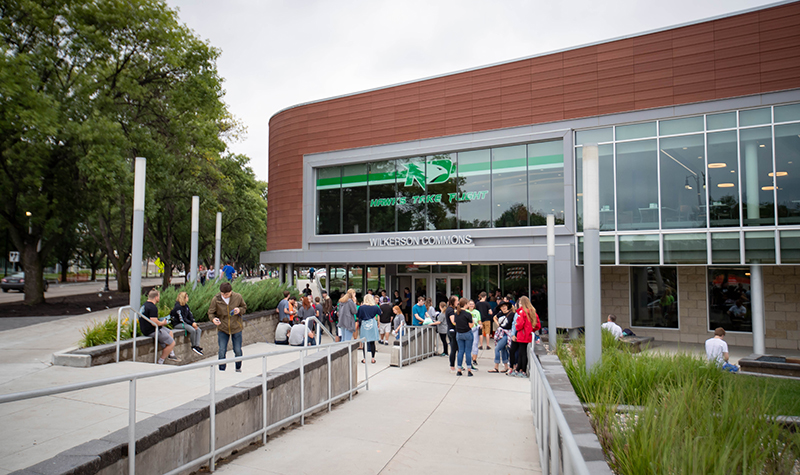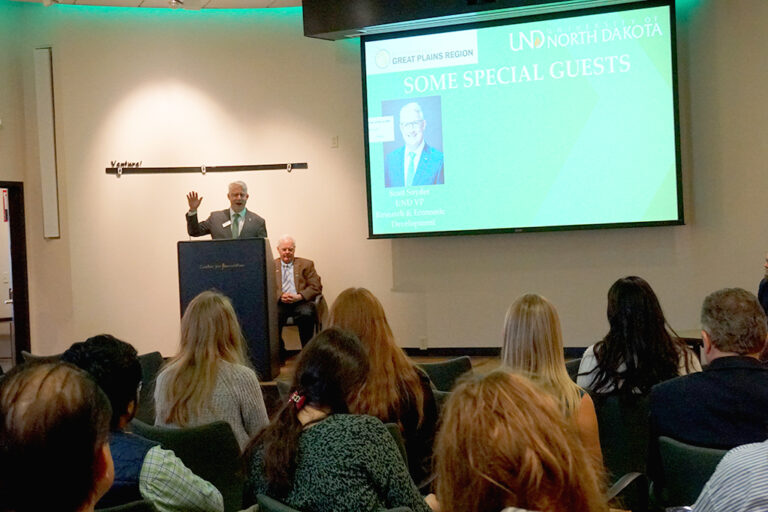How UND safely feeds students amid ‘social distancing’
From 3,000 meals a day to a few hundred takeout orders, UND Dining adjusts to COVID-19 concerns

Changes across campus in response to the novel coronavirus are happening at an unprecedented pace. While spring break typically presents a low-volume situation for UND Dining Services, across its dining halls, coffee shops and retail options, the health considerations for both students and staff have required more radical adjustments.
UND Today caught up with Orlynn Rosaasen, dining services director, to find out how CDC recommendations and University directives are affecting such a crucial part of campus life, and what that looks like now that most students are living at home or somewhere else off-campus.
As Provost Tom DiLorenzo said at the March 11 Provost Forum, the situation is especially difficulty because so many components of the University, especially dining, are focused on bringing people together and creating spaces for socialization among peers. As Rosaasen alludes to in the following Q&A, many functions of UND’s values are challenging to achieve in a time of social distancing and remote education.
The following has been lightly edited for clarity
How is your department handling the changes on campus as UND addresses COVID-19? How are its operations changing from what’s typical for the spring break period?

From an operational standpoint, we’re down to just Wilkerson Dining Center being available. It’s on a limited basis, and we’re doing breakfast, lunch and dinner in short windows of time. Everything other than Wilkerson – retail locations, coffee shops, etc. – was closed, as of Monday, March 16.
The bigger thing is that everything is takeout. The dining room in Wilkerson has been closed. Nobody is allowed to go in there, so there isn’t that congregating of people in one place. We have increased the amount of sanitizer stations in the service area so students and staff readily have access to hand sanitizer.
The other big change with switching to takeout is that staff are now serving everything – there is no longer self-service of any kind for students. They aren’t allowed to touch tongs or anything like that. This is all to cut down on contamination of utensils.
How are students’ health and safety being kept top of mind through these changes?
These changes were made in the interest of students and everyone else’s well-being. Any time that you have multiple people touching utensils, you’re going to have those utensils contaminated. So we’ve been looking at best practices and ways to eliminate points of contact. That’s what was taken into consideration in terms of eliminating self-service in Wilkerson. It was also in their best interest with regard to the takeout containers.
Again, with CDC guidelines at the time this was implemented, they were talking about groups less than 50. Now it’s groups less than 10. We felt that we could not keep a dining room open and be able to control groups of that size. Students have a tendency to congregate, and what we’ve been trying to create all these years is a location for socialization. Now we’re trying to slow it down, so it goes against what we’ve tried to do for a long time.
UND is moving to a period of remote instruction following spring break. What contingencies are in place should the period extend past Friday, April 3?
We would continue to do what we’re doing at this point in time, but it also depends on the direction campus goes and decisions made by the administration. I think a lot of those decisions need to be made at the campus level that impacts what we’re doing. I’m not able to answer beyond that.
Nonessential employees have been told to work from home. How does this affect your operations on campus, and how will you still deliver the services students require?
It’s pretty tough for us, with the work we do, to do it remotely. So, my staff here who are actually on campus – they’re working on a rotational basis, since we don’t need as many people every day as what we would have when everything is operational. The rotation is getting everybody some hours, and others are home and on-call. Because, again, you can’t produce food remotely.
Eliminating self-service has increased the number of people that it would take for us to serve food; for example, even though the numbers on campus are small, we’re pre-packaging salads and similar items. Typically, a student would just serve themselves at the salad bar, so that takes extra hands to get done, and it has to be done here.
Is the rate of service delivery low compared to most years? Is it similar with regard to how many students stick around campus?
I think it’s typical of what we see over spring break. I don’t think it’s any lower than what it has been in years past. We are serving anywhere from 100 to 150 students a day. This is also similar to semester breaks.
What are you seeing for the impact of these changes, regarding how many meals are served, and the amount of food that is prepared each day?
Our volume of food production is greatly decreased – again, because we’re only serving 100-plus students. We don’t have every service platform open, and we have three hot food service platforms currently available. From serving well over 3,000 meals a day down to a couple hundred, you can imagine the difference in production.
We’ve dropped our deliveries from our prime vendor down to three days a week instead of five. We’re maintaining those deliveries so we have access to product if we need it. As an example, during the academic session, we bring in 7 pallets of groceries a day. Now we’re bringing in 25 cases, which is about a third of a pallet.
Where can students and parents find information about changes to dining and housing arrangements? How do you plan to keep people up to date on planning around this situation?
UND Dining has its own blog, which is linked from the UND Dining homepage. People can get the latest information about what’s open, and that will be our primary channel that we’ll utilize with matters related to dining.



